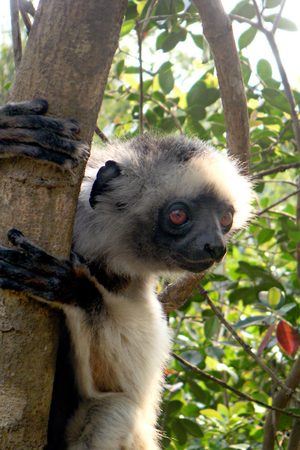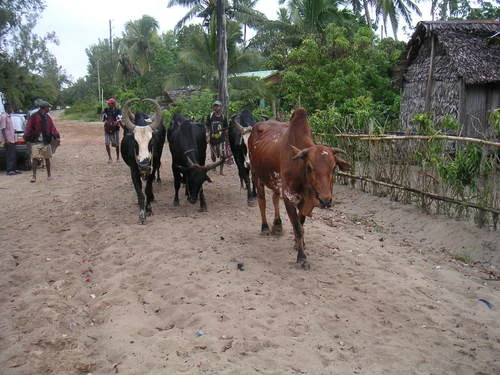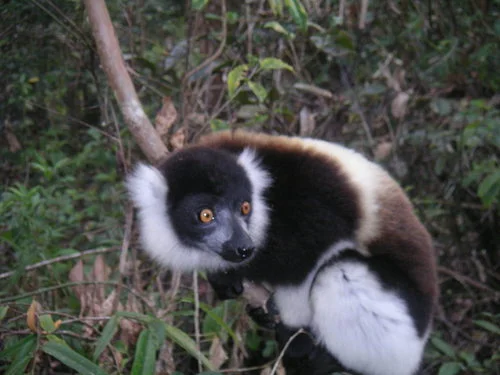Cliff and I get off the plane in Madagascar after a 28-hour marathon from the USA. Bleary eyed, I'm thinking to myself, "How in the world did Cliff come up with this one?" The answer consists of one word: "lemurs."
Sifaka Lemur
This is the fourth largest island in the world, found off the southeast coast of Africa in the Indian Ocean. The geography and history of this island-nation is fascinating. It turns out that as a result of the breakup of the supercontinent of Gondwana, Madagascar was released from the Indian peninsula approximately 88 million years ago. Due to the isolation of this landmass, a hotspot for biodiversity was able to evolve. Consequently, 90% of the wildlife found here is unique. This includes lemurs.
Lemurs are strepsirrhine primates that are endemic to Madagascar. They share morphological and behavioral traits with basal primates. This is as opposed to ancestral primates including monkeys, apes and humans. Geologists estimate that they arrived here by rafting on mats of vegetation approximately 62-65 million years ago. Today, up to 100 species of lemurs exist. Our object is to see as many as we can on this 2-week trip. We hire a guide who is a naturalist and speaks English. This is exciting!
Zebu
The first thing I come to realize is that this area is poor with 90% of the population existing on $2 a day. Because of this, the infrastructure is suboptimal, making travel to different parts of the island a challenge. We end up taking small private planes, some of which land in fields that act as runways. When the locals hear that a plane is going to land, they come watch the spectacle.
Our first stop is the Perinet Game Reserve, part of the Rainforest of the Atsinanana, a World Heritage Site. We get up before dawn and enter the reserve in search of the famous Indri lemur. This is one animal that you hear long before you see. They have loud vocalizations in the early morning hours as they communicate with other members of their group.
Black-and-white Ruffed Lemur
We come across a Diademed Sifaka lemur, a medium-sized primate that ranges from 16-22 inches and weighs 6.6-23.2 lbs. It is very distinctive with fur that is long and silky. Its coloration varies between yellowish-white to black-brown.
We then fly to Maronsetra, a market town and domestic seaport at the northern end of the Bay of Antongil. We are taken through canals and marshlands where we see fishing boats coming back from 2-week excursions. There are numerous little boats transporting rice that was recently harvested. We encounter a group of zebu, sometimes known as humped back cattle. I've never seen these animals before, which are used as draft oxen, and dairy and beef cattle. As Dorothy from The Wizard of Oz would say, "I've a feeling we're not in Kansas anymore."
Brown Lemur
Continuing on our journey, we hit the small island of Nosy Mangabe in Antongil Bay. This is a tropical rainforest preserve and sanctuary where we hope to see the endangered aye-aye. While the aye-aye are not to be seen on this day, we do come across a black -and-white ruffed lemur who has just descended from a high canopy on the eastern side of the island. He starts feeding on fruit that I understand to be his favorite meal.
Our series of flights continue as we touch down in Berenty in the south. This has a reserve along the Mandrake River amid a semi-arid, spiny forest. This area has been used for 3 decades as an important research site for primatologists. Here we run into a brown lemur, recognizable by its distinctive face that appears dark grey or black. I see that its eyebrow patches are pale and its eyes are orange-red. These dudes are cool looking!
As Cliff and I are on the plane headed home, I realize that I have seen the natural habitat of these basal primates that evolved and thrived on an isolated island off the coast of Africa. I am confident that I will see lemurs again on television or in zoos. However, I now know where they came from and how they got there. What a world!





